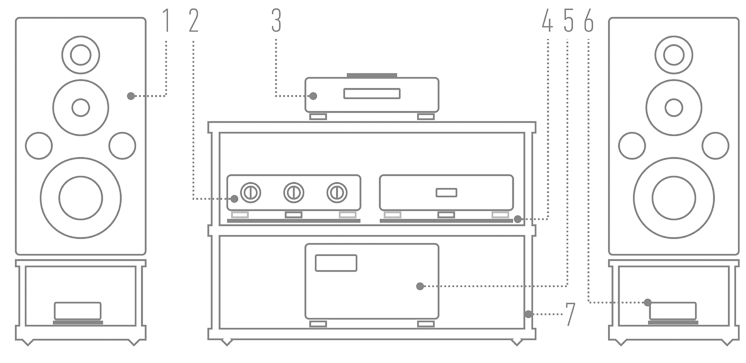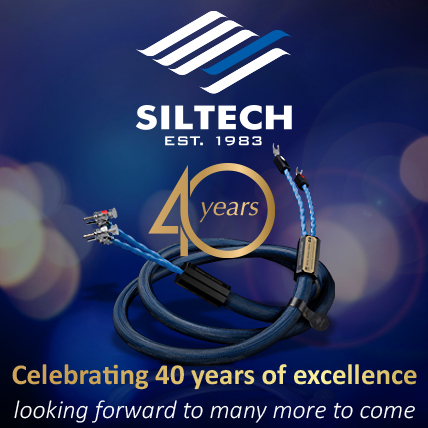|
HEADPHONE AMPLIFIER ⸜ tube VIVA
Manufacturer: VIVA AUDIO DEVICES |

|
Review
text WOJCIECH PACUŁA |

|
No 255 1 lipca 2025 |
THIS IS HOW I IMAGINE IT: a comfortable armchair, behind it a cool, designer lamp – for example, a Hopper – and next to it, on a nice table, an Egoista 2A3 amplifier and headphones hanging on Klutz Design CanCans (more → HERE ˻PL˺), absolutely the same color as the amplifier itself, as it can be ordered in any color. And another source, such as a SACD player or turntable. 
The armchair wouldn’t necessarily have to be the "iconic" Eames Lounge Chair. Launched in 1956, the chair was designed by Charles and Ray Eames and is made of molded plywood and leather. It has become almost meme-like because it is used in almost every advertisement for premium or pretentious products. The amplifier in question is not only a high-end product, but it also satisfies aesthetic needs, which is why I took this short trip. The Viva Egoista 2A3 is one of the larger headphone amplifiers we'll encounter. Not the largest, as amplifiers driving electrostatic headphones from companies like Woo Audio or HiFiMAN are even more impressive, but large enough to leave a lasting impression. Additionally, let's add that this isn't even the largest amplifier of this type in Viva's lineup – that honor goes to the Egoista 845 model, based on 845 triodes. The 2A3 model is a tube headphone amplifier with a solid-state power supply, based on two triodes in each channel – an input 6C45Pi and an output 2A3, one of the most highly regarded power triodes. The first one is manufactured the Russian Sovtek, the second by the Chinese company Psvane. Although I would prefer to see tubes from a country that is not an aggressor and does not threaten us in amplifiers purchased in Europe, I know there is a big problem with this, mainly in the repeatability and durability of tubes from other suppliers. ▲ The 2A3 THE FIRST WIDELY USED AMPLIFYING TUBE was the directly heated triode RCA 01A, developed in 1922. In the late 1920s, other specialized tubes appeared, such as the RCA 27, an indirectly heated triode, followed by the 37, 56, and 76 models. In 1926, another directly heated lamp, model 71, appeared on the market, followed by model 45 in 1928. Subsequent developments were the PX4 from 1929, the PX25 from 1930, and finally the most famous triodes today, the 2A3 models from 1932, the 300A from 1936, and the 300B from 1938. 
It's not encountered very often because it requires high-efficiency loudspeakers. In “High Fidelity” we tested such devices: → FI 2A3, Fezz Audio → MIRA CETI 2A3, Phasemation → MA-1000 and Tektron → TK2A3/50M-REF. ● The beautiful, directly heated 2A3 triode was introduced to the market by the American company RCA (Radio Corporation of America) on January 10, 1933, in a version without support rods, and from 1934 onwards, with support rods. The Sylvania Single Plate version dates back to 1935. In February 1936, RCA replaced the single plate with two smaller elements similar to those we know from the 45 triode, connected in parallel with the "W" filament. The 2A3 is a directly heated triode (DHT) designed for audio applications. Its name encodes the filament voltage ('2'), which is actually 2.5 V, its application: amplifiers ('a = amplifier'), and its type: triode ('3'). In the SET configuration, it is capable of delivering approximately 3-4 W of power, depending on the supply voltage. It is also often found in parallel configurations, with a common anode system, as well as in push-pull circuits. As it's a directly heated lamp, hum is a problem that designers deal with in various ways. ALTHOUGH THE EGOIST 2A3 IS A LARGE DEVICE, it is also a very sleek one. Its artistic design is very "Italian", in the sense that it is refined and simply good. It's a combination of organic forms with a rounded outline reminiscent of Art Deco. The front and back are made of lacquered wood, and the remaining elements are made of aluminum sheets. The upper "bonnet" is available in black or gray as standard. For an additional fee, it can be ordered in any car paint color – which is cool. The manufacturer writes: "The Egoista 2A3 comes in a virtually unlimited array of colors. You can personalize your Egoista to match your interior." The amplifier stands on four brass feet, and brass – as is well known – is valued for the way it dampens vibrations. The device operates in Class A without global feedback and offers two types of headphone outputs – an unbalanced 6.35 mm TRS, the so-called "large jack," and a four-pin XLR, designed for balanced connections. However, it's not a balanced device; it has a single triode at the output and is a classic SET amplifier. So, it seems this is a feature intended to increase the device's functionality. Similarly, the XLR input is one of the four analog inputs we get. It only connects the "hot" pin and ground, so it's an unbalanced connection. 
We'll send the signal through one of five inputs – which is quite a lot for a tube amplifier and suggests that the Egoist should be the center of the audio system, with a CD or SACD player, turntable, file player, and other sources. The first input is equipped with an XLR socket, but it is not a balanced input. The next three are classic RCA jacks, and the fourth one is a "direct" input, which bypasses volume control in the Egoist. You can connect sources with their own volume control to it. The manufacturer is very sparing in providing measurable parameters, including output power, bandwidth, or distortion. To be honest, we won't learn anything more besides the dimensions and weight. However, looking inside, we'll see very good components, including power and output transformers that even a large, classic speaker amplifier wouldn't scoff at. There are also other delicacies, mentioned in the design section here. The power supply is separate for each channel because the Egoista 2A3 is a dual-mono design. We use convenient knobs on the front to change the active input and volume, and the toggle switch to turn the device on. The switch has three positions. The middle one is where the amplifier is off, and the top one is where it's on. However, there is also a lower position where we turn on filament voltage and slowly allow anode voltage to be applied to the tubes. After a moment, we flip the switch and turn on the amplifier. This is a way to protect the tubes. That's cool, but I'd prefer it if it happened automatically. The amplifier is big, but it's nice – I really liked it. And as I say, details are important in this design, not just the overall impression. And there are quite a few of them, like the LED (unfortunately blue) embedded in the Viva logo, where it serves as the dot over the "i" – literally and figuratively. ▌ THE LISTENING SESSION THE WAY WE LISTENED • I tested the Viva Egoista 2A3 headphone amplifier in the "High Fidelity" reference system. As a source, it uses an Ayon Audio CD-35 HF Edition SACD player and a Lumin T3 file player; the latter will soon find a new home because my new three-piece Sforzato file player (DSP-05EX & PMX-05EX) has just arrived. 
During the test, I also used four pairs of headphones that I've been using for years and one brand new pair: the HiFiMAN HE-1000 v2 and Fosi Audio i5 magnetostatic headphones (test in the same issue of HF), as well as the Sennheiser HD 800 and AKG K271 Studio dynamic headphones: » ALBUMS USED IN THE TEST ⸜ a selection
⸜ WARREN BERNHARDT TRIO, Warren Bernhardt Trio '83, dmp CD-414, CD ⸜ 1983. WE ENTER THE WORLD OF THE EGOIST SLOWLY. There's nothing rushed about it, no attempts to grab our attention in the first few bars, we're not the subject of actions aimed at quickly convincing us that we must spend money here and now. Instead, we have the feeling of immersing ourselves in an unknown, intriguing, new experience. What needs to be said is that listening through speakers using the best SET amplifiers is reminiscent of it. It's about a particular way of shaping sound. It consists of full transparency and resolution while maintaining the fill. I listened to the album Warren Bernhardt Trio '83 by WARREN BERNHARDT TRIO specifically with this in mind. Issued, as you can see, in 1983 by dmp, a pioneer of digital recordings in the USA, it was recorded directly onto two tracks of a Mitsubishi X-80 digital tape recorder. Directly, meaning without recording anything afterwards. And the X-80 is one of the best mastering tape recorders in general, regardless of whether we're talking about the digital or the analog. 
The Viva amplifier played it better than any amplifier I've heard so far. Perhaps only the dCS Lina showed something like this. But even that's not quite right. The Egoista 2A3 did justice to this recording with its excellent clarity, selectivity and brilliant dynamics. At the same time, it didn't drag the sound towards becoming glassy, which is easy to do with early digital recordings – apart from Denon PCM Digital. It's easy because, as I understand it, a large part of electronics can't handle the large amount of information fed in at the higher midrange. It gets lost and moves towards brightening up, or lowers that part of the range, playing pleasantly and warmly. However, the Viva device shows us there's more music there than we get in that case, that there are a lot more emotions. So, the amplifier from Italy and Latvia is a "resolution machine." It superbly differentiates tonality, dynamics, and space. And it never moves towards ugliness, at least not the kind that comes from the inadequacy of electronic sound. It's more towards the internal truth of the recording. That's why not only polished recordings, like the aforementioned Warren Bernhardt Trio '83, or the completely different but equally excellent New Vienna by KEITH JARRETT, but also intentionally "dirty" analog music, recorded the way it was done in the 1970s, will sound equally wonderful. With albums like THE WHITE STRIPES duo’s Elephant, released on a SACD in 2023, the sound will be surprisingly diverse and spatial. The last thing you could say about most recordings of this type is "spatial", but guitarist Jack White’s and drummer Meg White's albums are exceptional in this regard. Jack is passionate about vintage equipment and records only in analog. And that dirt, that edginess, were clear with the Egoist. Nomen omen, one might add. At the same time, the device doesn't focus on any specific part of the band. It plays very, very evenly from the treble to bass. It can play very low bass but never pumps it up or flaunts it. It's more about conveying scale and depth without too much or exaggerated mass. I remember a similar approach to this range from the Sennheiser Orpheus electrostatic headphones – with the Viva amplifier and HiFiMAN headphones, it was a very similar experience: very sensual, very energetic, and at the same time perfectly diverse, in every way. 
So, it's no surprise that the incredibly juicy, yet in some ways "technical" sound from VOLBEAT's latest album, God OF Angel Trust, was presented by Viva exactly as I imagined it when I pre-ordered the new album (along with a signed artbook :). |
Its sound turned out to be more tonally and dynamically flattened than what I heard with the White's album, with a clearer midrange and less accentuated treble. But even in this manner, the Italian amplifier found its footing without hesitation. It was simply lighter and less saturated sound, which doesn't mean less interesting. ▲ Our albums SETH MacFARLANE Verve Records | Republic Records 602478075445 
Lush Life. The Lost Sinatra Arrangements IS THE NINTH STUDIO ALBUM by the American actor and singer Seth MacFarlane. The album was released on June 6, 2025 by Republic Records and Verve Records, and was preceded by the digital (unfortunately, only digital) single Lush Life, which was released on April 23, exactly on my name day. The second single, Give Me the Simple Life, was released on May 19, a few days before my birthday. Maybe that's why I have a soft spot for this album... It's no coincidence that MacFarlane sings "Sinatra". In 2018, the artist acquired the entire Sinatra music archive from his family, as he is an absolute fan. The album in question is a tribute to his idol and contains twelve songs that Sinatra had planned to perform but never did. MacFarlane and Joel McNeely hired an orchestra and recorded the entire album at the Fox Studio Lot. The recording took place at the excellent Skywalker Sound owned by George Lucas, and the orchestra was conducted by John Wilson, who the singer had previously performed with at the BBC Proms in 2009, 2010, 2012 and 2015. The album was released on Compact Disc and Long Play. The latter is also available on blue vinyl, and the former was available for a while with a small card hand-signed by the artist – and this is the version we are presenting to you. The CD was pressed separately in the USA and Europe. In Europe there is a very good Sony DADC pressing plant, so it's a shame this isn't an SACD – most discs of this type are produced at DADC. Besides, it's a wonderful album! It's not an imitation or a copy, but a reference, a tribute, and a tasteful one. MacFarlane's vocals are deep, velvety, yet he doesn't imitate Sinatra's singing. It's simply similar sensitivity, and they could easily perform one after the other on the same stage, or even together, like Sinatra and Dean Martin. 
And there is great sound, too. Lush Life. The Lost Sinatra Arrangements has the sweep of brass, the broad panorama of the orchestra, simply – breath. There's something on this album that I think I last heard on Sinatra's Duets, recorded on an analog tape recorder with the entire band playing in two studios simultaneously. The vocals are shown close to us, but are immersed in a large space, which gives them a large volume; they are not just a comma in the air. And the deep "pops" known from 1950s recordings have been preserved, which were later fanatically tracked down and edited out by sound engineers. The pianos heard at the beginning of the title track, Lush Life, are shown from a distance, as if we were looking into a ballroom from behind a curtain. I think that's what it was about, restoring jazz music – because that's what swing is – to its original function, which is a backdrop for dancing. That's why it's an incredibly smooth, rhythmic, and perfectly balanced album. Beautiful. » Sound quality: 9/10 AS I MENTIONED A MOMENT AGO, the differentiation offered by the tested amplifier is above average. This "internal" differentiation reveals changes in color, space, dynamics, recording techniques and the headphones connected to it. It’s because when I played BLACK SABBATH's Paranoid on Tidal, available there in a 2012 remaster, everything changed again. Positioned far back on the stage, with strong reverb and delay, Ozzy Osbourne's vocals were clear and distinct, while the guitars spread across the channels, filling the space to the sides. It was playing music in the midrange, but completely filled. However, JUDAS PRIEST's Exciter, with more interestingly recorded guitar but almost no low bass, sounded yet different. Each time, the clarity offered by the Viva amp was complemented by excellent resolution. And that meant I had both the sound inside, its attack and decay. It was, to refer to the title mentioned above, an exciting experience. And even if there was a lot of midrange, like in NAZARETH's Hair of the Dog, it made sense because it showed the band in a concert manner. And when the amp played the brilliantly produced Lamborghini by the band SCARLET PLEASURE, I also knew that heavily produced, contemporary records would be showcased with just as much heart. And I think that's what it's about, the big heart for music that's hidden inside this amplifier. The device displays colors the way we'd like them to be displayed, it renders dynamics the way we'd like them to be rendered, and the soundstage – well, the soundstage is better than we thought was possible with headphones. And it's not just with binaural recordings or Dolby Atmos, but also with recordings that are difficult to describe as "spatial". All the rock recordings mentioned above sounded wonderfully multi-dimensional, and recordings of refined culture, like the aforementioned Jarrett, or the excellent Labastida by NIKLAS PASCHBURG, will transport us right into the heart of the event. Sound will surround us, and although it will be "in our heads," that head will be large, vast. When FRANK SINATRA sings from one of his monophonic albums, such as In a Wee Small Hours, we get big, beautiful vocals, but without it being overdone or saturated with low frequencies. OUTPUTS & HEADPHONES • I have mentioned that the Viva Egoist 2A3 is an extremely resolving device. Maybe I didn't even "mention" it, but I keep reminding you about it every now and then – okay... This allows you to choose headphones to your liking, rather than based on how they work with the device. This is because the amplifier seems to "follow" parameters to a small extent, but rather shows the transducers connected to it as they are. And so, with the HiFiMAN HE-1000 v2, the sound was wide in color and dynamics, and it was also very spatial. Its tone color was full, but the last thing you could say about it was "warm". In contrast, with the warmer-sounding Fose Audio i5, tested in the same issue "High Fidelity", I got more rounded, lower-seated sound – less diverse, but very densely filled with sounds. You could say it's warmer and not as spacious as with the HE-1000 v2. The Viva Egoist 2A3 demonstrated the most classic sound with the Sennheiser HD 800s. Sinatra's vocals were brought closer to me and presented in a big way, with an emphasis on the low midrange, but also with excellent details, such as turning the sheet music page at 1:04 of ˻ 3 ˺ I Am Glad To Be Unhappy, with perfectly accented word endings, in which this crooner was a master. But it wasn't exaggerated, just clear. The Viva amp produced the warmest, most "midrange" sound when it played with classic studio headphones, namely the AKG K 271 Studio. This sound was very close to me, without as many details as before, but still appealing to sensitivity. And it was very versatile. Both Sinatra and LORDE in the new song Hammer and other tracks I listened to on Tidal, were all cool, enjoyable, but also diverse, never the same. 
As for the outputs, the Viva Egoista 2A3 offers an unbalanced output on a 6.35 mm TRS jack ("large jack") and a balanced 4-pin XLR output. The sound on both has the same volume level, but it's not the same. In my opinion, the "jack" sounds better. The sound is more compact and slightly more open with it. The XLR output seems slightly more muffled. These aren't big differences, but I heard them with both the Sennheiser HD 800 and the HiFiMAN HE-1000 v2. ▌ Conclusions THE 2A3 TUBE USED IN THE EGOISTA MODEL is a directly heated triode known for its high quality in audio amplifiers, particularly in single-ended (SET) configurations. If we were to ask people who have knowledge about it, they would probably say it's a popular choice because of its warm, pleasant sound. That's how this type of devices is often described in the literature. But that's not it, not at all. I think people confuse two completely different characteristics of sound. The "warmth" being referred to is something completely different from the "warmth" of EL34 tubes and similar ones. It's not really about warming, but about an organic quality. This results in exceptional resolution, which in turn leads to the reproduction of midrange sounds that are usually inaudible. And because we are particularly sensitive to the midrange, this sudden richness suggests playing with a warm midrange. The Egoista 2A3 helps you understand what directly heated triodes like the 2A3 are all about. That's why it's an amplifier you can fall in love with. If someone is missing the treble or bass in it, please don't be offended, but I say this with affection and love: their hearing is out of calibration and it's high time they listened to something with complex and balanced sound, like the Egoista 2A3. ▌ DESIGN THE VIVA AUDIO DEVICES COMPANY, which owns the Viva brand, is a special example of operating in two countries. Founded in Italy and run by Italians, its main headquarters (the main investor) and loudspeaker production plant are located in Latvia. It is, in fact, supported by the Latvian government. And the Baltic States are a hotbed of excellent manufacturers, e.g., the Lithuanian turntable manufacturer Reed or the phono cartridge manufacturer Aidas. The British Audio Note produces some of its products in this country as well. And in Estonia, there's the company Estelon. However, Viva Audio Devices builds its electronics in Italy. The amplifier tested was hand-assembled by the company's founder, Mr. Amedeo Schembri. The Egoista 2A3 headphone amplifier measures 410 × 185 × 410 mm and weighs 19 kg. Its enclosure is made of thick aluminum sheets, to which the top is screwed, forming a single unit with the sides. The edges of this "bonnet" – if I may draw a parallel with cars – are rounded, which looks nice. The front and back are made of wood covered with high-gloss black lacquer. The "bonnet" can be painted in any color from the RAL palette. The manufacturer speaks of "iconic variants" – Rosso Corsa red and Racing Yellow, known from supercars, specifically Ferrari and Porsche, respectively. The knobs are aluminum, and we can use them to change the volume and input. The switch on the left activates the device or puts it into "warming up" mode. The 6.3 mm TRS and 4-pin XLTR connectors are not, as usual, Neutrik ones, but from a different company. On the back, you can find four gold-plated inputs: three RCA and one XLR. There is also an IEC power socket with fuses. As for electronics, the interior of the device is reminiscent of the 1950s and 1960s, and of contemporary Japanese and Italian devices – this is point-to-point assembly. Eliminating printed circuit boards shortens the signal path and reduces the number of connections. However, it requires significantly more work to assemble the whole thing. In the tested amplifier, the powerful double C-core power transformers and equally large output transformers are noteworthy. To be honest, they are just as large as those in powerful amplifiers designed to drive speakers. It's also classic to run the long axes from the front of the device to the mechanical input selector and the potentiometer, which is located at the input of the circuit; this is a rotary potentiometer from the Japanese company Alps. Everything here is very "custom" and "classic". Signal is routed from the inputs to the switch via silver wires that look like vintage cabling. Pieces of felt have been glued onto the switch and electrolytic capacitors, which I assume is intended to dampen vibrations. It's the type of felt similar to what we put under furniture – apparently it works. 
The system features many good components, including the coupling capacitors for the 2A3 and 6C45Pi tubes. These are actually two capacitors in parallel – a classic Rifa film capacitor and a polypropylene one. This is done when we want to achieve specific sound and a single capacitor doesn't give us that. An incredibly classic, nicely looking setup. ● ▌ Technical specifications (according to the manufacturer)
Tube complement: 2 x 6C45Pi, 2 x 2A3 » W tekście znalazł się afiliowany link do sklepu internetowego → CD JAPAN. 
THIS TEST HAS BEEN DESIGNED ACCORDING TO THE GUIDELINES adopted by the Association of International Audiophile Publications, an international audio press association concerned with ethical and professional standards in our industry, of which HIGH FIDELITY is a founding member. More about the association and its constituent titles → HERE. |

|
Reference system 2025 |
|
 1) Loudspeakers: HARBETH M40.1 |REVIEW| 2) Line preamplifier: AYON AUDIO Spheris III Linestage |REVIEW| 3) Super Audio CD Player: AYON AUDIO CD-35 HF Edition No. 01/50 |REVIEW| 4) Stands (loudspeakers): ACOUSTIC REVIVE (custom) |ABOUT| 5) Power amplifier: SOULUTION 710 6) Loudspeaker filter: SPEC REAL-SOUND PROCESSOR RSP-AZ9EX (prototype) |REVIEW| 7) Hi-Fi rack: Hi-Fi rack: finite elemente MASTER REFERENCE PAGODE EDITION Mk II, more → HERE |
|

|
Cables Analog interconnect SACD Player - Line preamplifier: SILTECH Triple Crown (1 m) |ABOUT|» ANALOG INTERCONNECT Line preamplifier → Power amplifier: Siltech ROYAL SINLGE CROWN RCA; review → HERE Speaker cable: SILTECH Triple Crown (2.5 m) |ABOUT| |

|
AC Power Power cable | Mains Power Distribution Block - SACD Player: SILTECH Triple CrownPower (2 m) |ARTICLE| » POWER CABLE Mains Power Distribution Block → Line preamplifier: Acoustic Revive ABSOLUTE-POWER CORD, review → HERE » POWER CABLE Mains Power Distribution Block → Power amplifier: Acoustic Revive ABSOLUTE-POWER CORD, review → HERE Power cable | Power Receptacle - Mains Power Distribution Block: ACROLINK Mexcel 7N-PC9500 (2 m) |ARTICLE| Power Receptacle: Acoustic Revive RTP-4eu ULTIMATE |REVIEW| » ANTI-VIBRATION PLATFORM under Acoustic Revive RTP-4eu ULTIMATE: Graphite Audio CLASSIC 100 ULTRA, review → HERE Power Supply Conditioner: Acoustic Revive RPC-1 |REVIEW| Power Supply Conditioner: Acoustic Revive RAS-14 Triple-C |REVIEW| Passive filter EMI/RFI: VERICTUM Block |REVIEW| |

|
Anti-vibration Speaker stands: ACOUSTIC REVIVE (custom)Hi-Fi rack: finite elemente MASTER REFERENCE PAGODE EDITION Mk II, more → HERE Anti-vibration platforms: ACOUSTIC REVIVE RAF-48H |ARTICLE| » ANTI-VIBRATIONAL FEET: |

|
Analogue Phono preamplifier: Phono cartridges:
Clamp: PATHE WINGS Titanium PW-Ti 770 | Limited Edition Record mats:
|

|
Headphones » HEADPHONE AMPLIFIER: Leben CS-600X, review → HEREHeadphones: Headphone Cables: Forza AudioWorks NOIR HYBRID HPC |
main page | archive | contact | kts
© 2009 HighFidelity, design by PikselStudio,
projektowanie stron www: Indecity



















